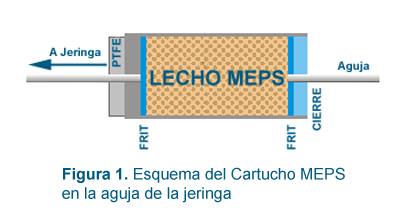 ¿Qué
es MEPS? ¿Qué
es MEPS?
MEPS es Micro Extraction by Packed Sorbent y es un nuevo desarrollo en el campo de la
preparación y manipulación de muestras. MEPS es la miniaturización de la
SPE convencional de volúmenes de lecho empacado de mililitros a
microlitros.
La aproximación de MEPS a la preparación de la muestra es adecuada para
fases reversas, fases normales, fases de modo mixto o de intercambio
iónico. MEPS está disponible en una amplia variedad de fases de SPE
convencionales.
El cartucho (Pendiente de Patente), contiene la fase estacionaria y es
solidario con la aguja de la jeringa (ver Figura 1).
¿Por qué
MEPS?
Históricamente, muchos métodos de preparación de muestras utilizan la
extracción líquido-líquido (LLE) que requiere grandes volúmenes de
muestra. Las ventajas de la SPE sobre la LLE son que SPE requiere mucho
menos tiempo, puede evolucionar a una técnica totalmente automatizada,
necesita mucho menos solvente y ofrece selectividad.
MEPS realiza las mismas funciones que SPE: la eliminación de componentes
de la matriz que interfieren y el aislamiento y la concentración
selectiva de los analitos.
MEPS aumenta las ventajas de la SPE
convencional de las maneras siguientes:
- Reduce significativamente el tiempo necesario para preparar e
inyectar las muestras.
- Puede combinarse con inyectores automáticos de LC y GC - la
etapa de extracción e inyección se efectúan en línea usando la misma
jeringa.
- Reduce significativamente el volumen de solventes necesarios.
- Puede trabajar con muestras tan pequeñas como 3.6 µL, frente a
los varios centenares de mL con SPE.
Tamaño de Muestra y
Sensibilidad
Las muestras pueden ser tan pequeñas como 10
µL, o, tomando varias
alícuotas de 100
µL o 250
µL, pueden concentrarse muestras de 1 mL.
Automatización
La capacidad de extraer muestras y efectuar la inyección en línea
usando el mismo dispositivo reduce tanto los tiempos de procesado de
muestra como la necesidad de la intervención de un operador.
Vida del sorbente
La vida típica de un cartucho en la extracción de muestras de plasma
completo se estima entre 40 y 100 muestras. Estos valores son
conservadores y aumentan significativamente en muestras más limpias.
Efecto memoria
La pequeña cantidad de fase en el cartucho MEPS puede limpiarse
fácil y efectivamente entre muestras para reducir la posibilidad de
contaminacón por arrastre. El proceso de lavado resulta, simplemente, no
práctico en los sistemas SPE tradicionales. En un sistema automático, el
lavado puede efectuarse mientras se analiza la muestra previa.
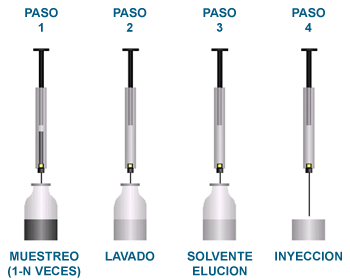 Flexible
y de fácil uso Flexible
y de fácil uso
Las dimensiones del lecho de sorbente asegura que las prestaciones
se mantienen iguales a los sistemas SPE convencionales cuando se usan
para la extracción de muestras similares. Los cartuchos MEPS pueden
usarse para volúmenes de muestra tan pequeños como 3.6
µL, haciéndolos
particularmente atractivos para su uso en línea para el análisis por
LC-MS de muestras de volumen limitado.
Cómo se usa MEPS
Pase la muestra a
través del cartucho MEPS (pueden tomarse uno o más volúmenes)Paso 2:
Lave el cartucho MEPS una vez pasando de 20 a 50
µL de solución de
lavado a través del cartucho para eliminar interferencias.Paso 3:
Eluya el analito pasando solvente a través del cartucho al barril de
la jeringa.Paso 4:
Inyecte el analito directamente en el inyector.Paso 5: Pase 50 µL de solvente y 50 µL de solución de lavado
para preparar el cartucho para la siguiente muestra.
Vea un video AQUÍ.
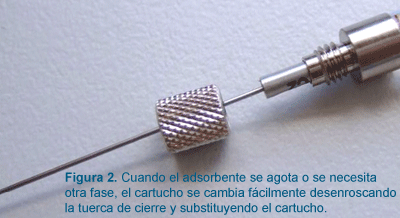 El
cartucho MEPS se instala fácilmente en la jeringa y se asegura mediante
una tuerca de cierre. El etiquetado individual de cada cartucho asegura
la fase estacionaria correcta en cada extracción. El
cartucho MEPS se instala fácilmente en la jeringa y se asegura mediante
una tuerca de cierre. El etiquetado individual de cada cartucho asegura
la fase estacionaria correcta en cada extracción.
Cuando el adsorbente se agota o se necesita otra fase, el cartucho se
cambia fácilmente desenroscando la tuerca de cierre y substituyendo el
cartucho (ver Figura 2).
¿Qué prestaciones tiene MEPS?
El tratamiento de muestras biológicas complejas se
adapta rápidamente al MEPS y reduce el volumen de muestra y reactivos
necesarios cuando se le compara con la SPE convencional y otros "procedimientos
de micro extracción".
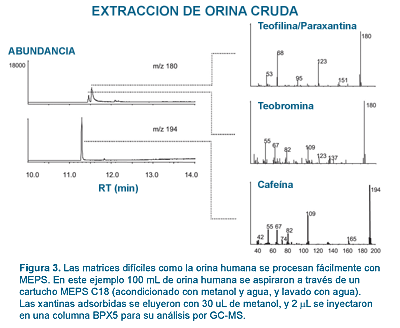 En la
Figura 3 se muestra la extracción de metabolitos de xantina de orina
humana cruda con un cartucho MEPS de C18 antes del análisis por GC-MS
donde puede verse como las matrices difíciles como la orina En la
Figura 3 se muestra la extracción de metabolitos de xantina de orina
humana cruda con un cartucho MEPS de C18 antes del análisis por GC-MS
donde puede verse como las matrices difíciles como la orina
 humana se procesan fácilmente con MEPS. En este ejemplo 100 µL de orina humana se aspiraron a través de un cartucho MEPS C18 (acondicionado con metanol y
agua, y lavado con agua). Las xantinas adsorbidas se eluyeron con 30 µL
de metanol, y 2 µL se inyectaron en una columna
BPX5 para su análisis por GC-MS. humana se procesan fácilmente con MEPS. En este ejemplo 100 µL de orina humana se aspiraron a través de un cartucho MEPS C18 (acondicionado con metanol y
agua, y lavado con agua). Las xantinas adsorbidas se eluyeron con 30 µL
de metanol, y 2 µL se inyectaron en una columna
BPX5 para su análisis por GC-MS.
En la Figura 4 siguiente, extracción de anestésicos de
plasma de rata con un cartucho MEPS de C2, antes del análisis por LC-MS,
muestras de plasma de rata fueron dopadas con anestésicos locales a
concentraciones finales de 2.4mmol/L, 2.5 mmol/L y 3.0 umol/L para la
Lidocaína, la Ropivacaína y la Bupivacaína respectivamente. Se aspiraron
50 µL del plasma dopado a través de un cartucho MEPS C2, lavado con agua
y eluído con 0,1% HCOOH en 25% ACN:75% Agua directamente en una
columna C18 de 100x2.1mm.
¿Cómo se compara MEPS en
Exactitud y Precisión?
La Tabla 1 resume la precisión y la exactitud de los resultados
obtenidos en el análisis de Ropivocaína según cuatro métodos de
tratamiento de muestras: MEPS, Extracción Líquido-Líquido (LLE), SPE
convencional y micro extracción en Fase Sólida (SPME). La comparación con
SPME, también una técnica de micro extracción, ha mostrado que MEPS
ofrece una mejor precisión y exactitud empleando un tiempo de procesado
de la muestra significativamente menor.
La Tabla 2 compara la precisión, la exactitud, los límites de detección
y los tiempos de extracción de MEPS frente a otras dos técnicas de
micro extracción, SPME y SBSE (Stirring Bar Sorbent Extraction), para
cinco PAH’s extraídos de agua. Los resultados de MEPS y SBSE son
significativamente mejores que con SPME pero MEPS procesa las muestras
en un tiempo 100 veces más rápido que SBSE.
|
|
Tabla 1:
Comparación de Exactitud y Precisión entre MEPS y otros métodos para
ropivacaína (anestésico local) |
|
Método |
Ropivacaína
LD (nM) |
Exactitud
% |
Precisión (RSD%)
(entre
ensayos) |
Tiempo de
procesado |
|
(1) MEPS / GC-MS |
2 |
105 |
5.0 |
1 min |
|
(2) LLE / GC-MS |
2 |
101 |
3.8 |
20 min |
|
(3) SPE / LC-UV |
100 |
101 |
3.0 |
20 min |
|
(4) SPME / GC-MS |
5 |
110 |
6.3 |
40 min |
|
M. Abdel-Rehim / J. of
Chromatography B, 801 (2004) 317-321 |
|
|
Tabla 2:
Comparación de Exactitud y Precisión de MEPS, SPME y SBSE en el análisis
de PAH’s en agua |
|
Compuesto |
Exactitud
% |
Precisión
(RSD%) |
Límite detección
(ng/L) |
Tiempo de
procesado (min) |
|
|
MEPS |
SPME |
SBSE |
MEPS |
SPME |
SBSE |
MEPS |
SPME |
SBSE |
MEPS |
SPME |
SBSE |
|
Antraceno |
84 |
81 |
99 |
12 |
3 |
6 |
5 |
100 |
1.2 |
2 |
30 |
200 |
|
Criseno |
107 |
81 |
100 |
1 |
4 |
5 |
5 |
90 |
0.2 |
2 |
30 |
200 |
|
Fluoranteno |
100 |
84 |
100 |
9 |
4 |
4 |
5 |
100 |
1.2 |
2 |
30 |
200 |
|
Fluoreno |
103 |
96 |
97 |
5 |
5 |
4 |
1 |
40 |
0.7 |
2 |
30 |
200 |
|
Pireno |
115 |
86 |
100 |
7 |
3 |
3 |
1 |
40 |
0.7 |
2 |
30 |
200 |
|
M. Abdel-Rehim / J.
Chromatog. A 1114 (2006) 234-238 |
|
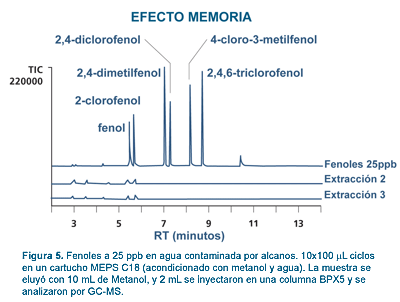 ¿El efecto memoria es
significativo en MEPS? ¿El efecto memoria es
significativo en MEPS?
Los accesorios
de SPE se han considerado tradicionalmente de un solo uso. La ingeniería
de precisión usada en el diseño y la fabricación de MEPS permiten
simples etapas de lavado y la consiguiente reutilización del cartucho.
Para demostrar este punto se han extraído fenoles de agua residual y se
ha medido el arrastre de muestra entre experimentos. En la Figura 5
se muestran los cromatogramas de tres extracciones de 10 µL.
La primera se ha etiquetado como "fenoles 25 ppb", la segunda
"extracción 2" y la tercera "extracción 3". Se ve claramente que en los
primeros 10 µL
de metanol se eluyen todos los fenoles.
Una de las razones generalmente aducidas para el uso de cartuchos SPE
desechables es el problema del efecto memoria.
El resultado de 5
estudios se resume en la Tabla 3.
Usando una serie de lavados con eluyente y luego con solución de lavado, se ha eliminado virtualmente el
efecto memoria. Con un ciclo de tiempo medido en segundos, para MEPS
este lavado se efectúa en menos de 5 minutos. Para obtener un resultado
equivalente en SPE convencional, se requeriría más de una hora y el uso
de cantidades bastante significativas de solventes.
Resumen
La Tabla 4 resume
la comparación de MEPS, SPME y SPE convencional. MEPS requiere mucho
menos tiempo que SPE o SPME, y muestra una recuperación y sensibilidad
bastante superiores. MEPS también elimina cualquier etapa intermedia
entre la preparación de la muestra y la inyección en el cromatógrafo de
Gases o de Líquidos. |
|
Tabla 3:
Comparación del arrastre de muestra y régimen de lavado. |
|
Método |
Volumen Lavado
µL |
#Lavados y Sol.
Lavado |
Arrastre de
Muestra |
Fuente |
|
PAH’s en agua |
50 |
4 x MeOH, 5 x H2O |
0.2-1% |
M. Abdel-Rehim /
J.Chromatog. A 1114(2006) 234-238 |
|
Anestésicos en Suero
Humano |
50 |
4 x MeOH, 4 x H2O |
~0.2% (I.S.) |
M. Abdel-Rehim /
J.Chromatog. B,801(2004)317-321 |
|
Roscovitina en Plasma y
Orina |
50 |
5X MeOH/H2O (95:5
V/V)
5X MeOH/H2O (90:10 V/V) |
<0.1% |
M. Abdel-Rehim /
J.Chromatog. B,817(2005)303-307 |
|
Roscovitina en Plasma
Humano |
50 |
4 x MeOH, 4 x H2O |
<0.01% |
M. Abdel-Rehim /
J.Mass Spectrom.204;39:1488-1493 |
|
Olomoucina en Plasma
Humano |
50 |
5X MeOH/H2O (95:5
V/V)
5X MeOH/H2O (90:10 V/V) |
<0.01% |
M. Abdel-Rehim /
Analytica Chimica Acta 2005 |
|
|
Tabla 4:
Comparación de MEPS, SPME y SPE convencional |
|
Factor |
MEPS |
SPE |
SPME |
Fuente |
|
Sorbente (mg) |
0.5-2 |
50-2000 |
150µm |
M. Abdel-Rehim /
J. of Chromatography B, 801 (2004) 317-321 |
|
Prep. Muestra (min) |
1-2 |
10-15 |
10-40 |
|
#Extracciones
Cartucho |
40 a 100 |
1 |
50-70 |
|
Recuperación |
buena |
buena |
baja |
|
Sensibilidad |
buena |
buena |
baja |
|
|
Publicaciones disponibles en MEPS |
Tipo |
|
|
Extraction of Phenols from Waste Water using
Micro Extraction by Packed Sorbent (MEPS).
MEPS is
the miniaturization of conventional SPE from milliliter to
microliter bed volumes that allows SPE to be used with very small
samples. The manipulation of the small volumes is achieved with a
precision gas tight syringe. With a typical void volume of 7 μL, the
MEPS elution is compatible with GC and LC inlets making it ideal for
integration into an automated sampling system for on-line SPE.
To demonstrate the usefulness of MEPS for dilute samples with a
relatively simple matrix, a surrogate wastewater sample was prepared
from clear phenol free waste water spiked with either 25 ppb or 250
ppt phenols. |
Aplicación. 345Kb |
 |
|
On-Site Sample Preparation Using MEPS for Waste
Water Analysis.
MEPS
uses a barrel insert and needle (BIN) device to reduce Solid-Phase
Extraction (SPE) to a micro-scale suitable for small volume samples
and for the on-line adaptation of conventional SPE techniques.
Because the SPE cartridge (BIN) is incorporated into the needle
assembly of a gas-tight syringe, MEPS is also a simple field-portable
SPE device that may be operated manually without need for sampling
pumps or, alternatively, may be incorporated into robotic
samplers.To demonstrate the application of MEPS we report the
qualitative field use of C18-MEPS for the sampling of water bodies
in both industrial and urban environments. Water samples were
extracted on-site and then the MEPS syringes were transported back
to the laboratory overnight for elution and analysis of the retained
components. C18-MEPS was used to extract samples (100-1000 μL) of
water from industrial drains and stormwater pipes to recover semi-volatile
residues for GCMS analysis (Fig 1-3). The technique was also applied
to sampling droplets on surface extracts of paint for non-destructive
surface profiling (Fig 2). Analysis of the unknown samples was
qualitative but sufficiently sensitive to detect industrial
discharge residues associated with grinding coolants, packaging
materials and other contaminants. Naturally occurring leachates from
vegetation were also detectable. Droplet extraction of a painted
surface was performed in reversed-phase mode (water extract on C18
sorbent) and allowed the surface to be profiled for comparative
purposes. The same technique could be applied in normal phase (data
not shown) using an organic solvent and a silica or C2 sorbent. |
Aplicación. 254Kb |
 |
|
MEPS for pollutants and small volume samples. |
Ejemplos. 506Kb |
 |
|
Application of MEPS coupled with Gas
Chromatography Time-Of-Flight Mass Spectrometry (GC-TOF MS) in
Analysis of Brominated Flame Retardants in Waste Water.
In last years, miniaturized analytical techniques had gained
attention due to its many special features over classical approaches.
Among many advantages, usage of little or no solvent, increasing of
sensitivity of analysis and user-friendly system, should be pointed
out. Micro extraction in packed sorbent (MEPS) is a new technique
for miniaturized solid-phase extraction that can be connected online
to gas chromatography (GC) or liquid chromatography (LC) without
other sample pre-treatment.1-4 The sample (10–250 μL) is withdrawn
through the syringe by an autosampler. When the sample has passed
through the solid support, the analytes are adsorbed to the solid
phase packed in a barrel insert and needle (BIN). The solid phase is
washed afterwards by water to remove any interfering material, and
the elution of analytes is performed directly into the instrument’s
injector by organic solvent (in case of GC), or the LC mobile phase.
The large injected volume, typically 10 to 50 μL, may imply the use
of programmed temperature vaporiser (PTV) and large volume injection
(LVI). Moreover, a large variety of special packed materials in BIN,
such restricted access material (RAM) or molecular imprinted
polymers (MIPs), can be used. |
Artículo. 284Kb |
 |
Development and validation of a liquid chromatography and tandem
mass spectrometry method for determination of roscovitine in plasma
and urine samples utilizing on-line sample preparation.
Roscovitine,
a purine analogue that selectively inhibits cyclin-dependent kinases,
has been considered as a potential anti-tumor drug. The
determination of roscovitine in plasma and urine was performed using
microextraction in packed syringe as on-line sample preparation
method with liquid chromatography and tandem mass spectrometry. The
sampling sorbent utilized was polystyrene polymer. 2H3-lidocaine was
used as internal standard. The limit of detection for roscovitine
was as low as 0.5 ng/mL and the lower limit of quantification was
1.0 ng/mL. The accuracy and precision values of quality control
samples were between±15% and≤11%, respectively. The calibration
curvewas obtained within the concentration range 0.5–2000 ng/mL in
both plasma and urine. The regression correlation coefficients for
plasma and urine samples were ≥0.999 for all runs. The present
method is
miniaturized and fully automated and can be used for pharmacokinetic
and pharmacodynamic studies. |
Artículo. 162Kb |
 |
Development of a
molecularly imprinted polymer based solid-phase extraction of local
anaesthetics from human plasma.
Molecular
imprints selective for a homologous series of local anaesthetics,
including bupivacaine, ropivacaine and mepivacaine, were prepared
and the resultant polymers were used for solid-phase extraction of
human plasma. The template was a structural analogue, pentycaine,
which was imprinted in methacrylic acid–ethylene glycol
dimethacrylate copolymers. Equilibrium ligand binding experiments
using radiolabelled bupivacaine were performed to characterize the
imprinted polymers, as well as to identify optimal conditions for
selective extraction of plasma samples. Dilution of the plasma prior
to extraction with citrate buffer pH 5.0 containing ethanol and
Tween 20 was found optimal for selective imprint–analyte binding,
and for reduction of non-specific adsorption of lipophilic
contaminants to the hydrophobic MIP surface. Wash steps using 20%
methanol in water followed by a solvent switch to 10% ethanol in
acetonitrile removed contaminants and strengthened the selective
imprint–analyte binding. Elution under basic conditions using
triethylamine–water–acetonitrile mixtures recovered bupivacaine in
89% yield with superior selectivity over elution under acidic
conditions. The final protocol extracted trace levels of ropivacaine
and bupivacaine from human plasma and allowed determination of
bupivacaine in the range of 3.9–500nmol L−1 and ropivacaine in the
range of 7.8–500 nmol L−1 with inter-assay accuracies of 94–99 and
95–104%, respectively. This present investigation provides an
improved understanding of approaches available for optimization of
protocols for molecular-imprint based solid-phase extraction of
plasma samples. |
Artículo. 123Kb |
 |
Fast and sensitive
environmental analysis utilizing microextraction in packed syringe
online with gas chromatography–mass spectrometry. Determination of
polycyclic aromatic hydrocarbons in water.
A new
sensitive, selective, fast and accurate technique for online sample
preparation was developed. Microextraction in a packed syringe (MEPS)
is a
new miniaturised, solid-phase extraction (SPE) technique that can be
connected online to GC or LC without any modifications. In MEPS
approximately 1mg of the solid packing material is inserted into a
syringe (100–250 ml) as a plug. Sample preparation takes place on
the packed bed. The bed can be coated to provide selective and
suitable sampling conditions. The new method is very promising. It
is very easy to use, fully automated, of low cost
and rapid in comparison with previously used methods. The
determination of polycyclic hydrocarbons (PAHs) in water was
performed using MEPS as sample preparation method online with gas
chromatography and mass spectrometry (MEPS–GC–MS). The results from
MEPS as sample preparation were compared with other techniques such
as stir bar sorptive extraction (SBSE) and solid-phase
microextraction (SPME). The method was validated and the standard
curves were evaluated by the means of quadratic regression and
weighted by inverse of the concentration: 1/x for the calibration
range 5–1000 ng/L. The MEPS applied polymer (silica-C8) could be
used more than 400 times before the syringe was discarded. The
extraction recovery was about 70%. The results showed close
correlation coefficients (R > 0.998) for all analytes in the
calibration range studied. The accuracy of MEPS–GC–MS was between 90
and 113% and the inter-day precision (n = 3 days), expressed as the
relative standard deviation (RSD%), was 8–16%. MEPS reduced the
handling time by 30 and 100 times compared to SPME and SBSE,
respectively. |
Artículo. 166Kb |
 |
New trend in sample
preparation: on-line microextraction in packed syringe for liquid
and gas chromatography applications
I. Determination of local anaesthetics in human plasma samples using
gas chromatography–mass spectrometry.
A new
technique for sample preparation on-line with LC and GC–MS assays
was developed. Microextraction in a packed syringe (MEPS) is a new
miniaturised, solid-phase extraction technique that can be connected
on-line to GC or LC without any modifications. In MEPS approximately
1mg of the solid packing material is inserted into a syringe
(100–250 l) as a plug. Sample preparation takes place on the packed
bed. The bed can be coated to provide selective and suitable
sampling conditions. The new method is very promising. It is very
easy to use, fully automated, of low cost and rapid in comparison
with previously used methods. This paper presents the development
and validation of a method for microextraction in packed syringe
MEPS on-line with GC–MS. Local anaesthetics in plasma samples were
used as model substances. The method was validated and the standard
curves were evaluated by the means of quadratic regression and
weighted by inverse of the concentration: 1/x for the calibration
range 5–2000 nM. The applied polymer could be used more than 100
times before the syringe was discarded. The extraction recovery was
between 60 and 90%. The results showed close correlation
coefficients (R > 0.99) for
all analytes in the calibration range
studied. The accuracy of MEPS–GC–MS was between 99 and 115% and the
inter-day precision (n = 3 days), expressed as the relative standard
deviation (R.S.D.%), was 3–10%. |
Artículo. 155Kb |
 |
Microextraction
in packed syringe (MEPS) for liquid and gas chromatographic
applications.
Part II—Determination of ropivacaine and its metabolites in human
plasma samples using MEPS with liquid chromatography/tandem mass
spectrometry.
A
new technique for sample preparation on-line with liquid
chromatographic/tandem mass spectrometric (LC/MS/MS) assay was
developed. Microextraction in a packed syringe (MEPS) is a new
miniaturized, solid-phase extraction technique that can be connected
on-line to gas or liquid chromatography without any modifications.
In MEPS 1 mg of the solid packing material is inserted into a
syringe (100–250 μl) as a plug. Sample preparation takes place on
the packed bed. The bed can be coated to provide selective and
suitable sampling conditions. The new method is very promising, very
easy to use, fully automated, of low cost and rapid in comparison
with previously used methods. This paper presents the development
and validation of a method for MEPS on-line with LC/MS/MS.
Ropivacaine and its metabolites (PPX and 3-OH-ropivacaine) in human
plasma samples were used as model substances. The method was
validated and the calibration curves were evaluated by means of
quadratic regression and weighted by the inverse of the
concentration, 1/x, for the calibration range 2–2000 nM. The applied
polymer could be used more than 100 times before the syringe was
discarded. The extraction recovery was between 40 and 60%. The
results showed high correlation coefficients (R2 > 0.999) for all
analytes in the calibration range studied. The accuracy, expressed
as a percentage variation from the nominal concentration values,
ranged from 0 to 6%. The precision, expressed as the relative
standard deviation, at three different concentrations (quality
control samples) was consistently about 2–10%. The limit of
quantification was 2 nM. |
Artículo. 149Kb |
 |
|
The Extraction of Saliva
for The Analysis of Basic Drugs Residues Using MEPS™-GCMS.
Oral fluid is considered a
desirable sample for regulatory screening of drugs of abuse and for
clinical monitoring because it may be collected in a non-
invasive
fashion when compared with the procedures used for collection of
urine and blood. Unlike urine, the appearance of the drug residues
in saliva may
be directly correlated with plasma drug concentrations.
The relatively low concentration of most drugs in saliva and the
small sample volume that is typically available for analysis makes
micro-extractive techniques both attractive and necessary for this
matrix. MEPS™ is a micro-scaled SPE device that is incorporated
directly into a liquid handling syringe and may be used with robotic
autosamplers for on-line chromatographic analysis. The small scale
of the MEPS™ device is effective for the extraction of small volume
samples and is therefore potentially valuable for the extraction of
oral fluids for GC-MS confirmatory analysis. We present here a
simple reversed-phase C18-MEPS™ extraction for saliva collected from
a patient that had been administered the local anaesthetic
mepivacaine for a dental procedure several hours previously. |
Artículo. 206Kb |
 |
|
The Micro-Extraction and
Detection of Phenolic Anti-Oxidants from Cereal Products Using MEPS™-GCMS.
Synthetic phenolic antioxidants
are increasingly rejected as acceptable food additives because of
their demonstrable or suspected adverse effects on human health.
Among the compounds of concern are the butylated hydroxyphenols such
as butylated hydroxy toluene (BHT), butylated hydroxy anisole (BHA)
and bisphenol A. Simple methods for the removal of food matrices are
necessary for the detection of these compounds in regulatory
compliance programmes. Micro-extraction Packed Sorbent (MEPS™) is a
solid-phase technique that allows rapid sample extraction by
reducing the volume of sample processed. Because the sorbent device
is incorporated directly into a liquid handling syringe, it may also
used with robotic autosamplers for on-line chromatographic analysis.
In this example, rice crackers manufactured with sunflower oil that
was stabilized with BHA |
Artículo. 967Kb |
 |
|
Measuring Fruit Juice
Adulteration by Changes in Flavonoid Content Using MEPS™ and HPLC.
Cranberry and blueberry juice
are notable example of functional foods that may be eroded in value
by dilution or adulteration with lower value products. The cranberry
is known as a source of polyphenolic antioxidants (including
anthocyanidin flavonoids, cyanidin, peonidin and quercetin) and is
the subject of investigation for potential anti-cancer properties
and its effects on the cardiovascular and immune systems. The
tannins are reputed to reduce urinary tract infections, exhibit
anticlotting properties and reduce gingivitis. Other fruits are also
known or reputed to have functional characteristics and therefore of
high value. A rapid Micro-Extraction Packet Sorbent (MEPS™) method
is described for extracting and concentrating the phenolic
components from a variety of commercial fruit juices. The juice was
passed through a C8 or C18 MEPS™ cartridge and the retained fraction
eluted with methanol for direct injection into a HPLC and analysis
on a ProteCo™l C18 GP125 column using a 0.1 % v/v aqueous
trifluoroacetic acid – methanol mobile phase. Detection of the
phenolic fraction at 350 nm was used to generate a characteristic
profile for each species of fruit. The method allowed profiling of
fruit juice and the detection of diluents or juice mixtures. Because
the solid-phase step is flowrate dependant, the small sample and
elution volumes of MEPS™ allow rapid sample extraction that may be
completed in realtime with the HPLC analysis. |
Artículo. 701Kb |
 |
The Extraction and
Analysis of Urinary Antitussive Metabolites using MEPS™ and ESI-LCMSn.
Microextraction Packed Sorbent (MEPS™) is an adaptation of SPE into
a miniaturized device with a typical void volume of less than 10 μL.
With operating volumes of this scale and its compatibility with
autosampler syringes, MEPS™ allows the specificity of the solid-phase
process to be harnessed for digital chromatography using
discontinuous changes in solvent polarity. The eluant volumes are
sufficiently small to be injected directly into a HPLC system and
therefore permit the on-line use of solid-phase extraction
methodology in real time with the HPLC. |
Artículo. 122Kb |
 |
MEPS: A New
Technique for the Analyisis of Small Brominated and Chlorinated
Aromatic Compounds in Wine.
The wine
industry has long suffered from TCA (2,4,6-trichloroanisole) and TBA
(2,4,6 tribromoanisole) contamination or “cork” taint. These
compounds more recently has been found to be present in corks,
packaging material, cardboard boxes, wooden products and many other
materials. Only 1-2 ng/l of TCA or TBA is required to give wine the
“musty” aroma associated with cork taint. It has been proposed that
chlorophenols are the precursor for TCA (Fig1). As dioxins are known
to be present as contaminants in chlorophenol formulations (1) they
might therefore also be present in the wine corks, a hypothesis that
needs further invesitigation. In this work, the analysis of TCA and
TBA is performed by a new technique for sample preparation called
Microextraction by Packed Sorbent (MEPS). This technique in
combination with different GCMS techniques is described below and
compared with other methods. |
Artículo. 318Kb |
 |
The application of
MEPS for the on-site preparation of water samples.
MEPS
uses a barrel insert and needle (BIN) device to reduce Solid-Phase
Extraction (SPE) to a micro-scale suitable for small volume samples
and for the on-line adaptation of conventional SPE techniques.
Because the SPE cartridge (BIN) is incorporated into the needle
assembly of a gas-tight syringe, MEPS is also a simple field-portable
SPE device that may be operated manually without need for sampling
pumps or, alternatively, may be incorporated into robotic samplers.
To demonstrate the application of MEPS we report the qualitative
field use of C18-MEPS for the sampling of water bodies in both
industrial and urban environments. Water samples were extracted on-site
and then the MEPS syringes were transported back to the laboratory
overnight for elution and analysis of the retained components.
C18-MEPS was used to extract samples (100-1000 μL) of water from
industrial drains and stormwater pipes to recover semi-volatile
residues for GCMS analysis (Fig 1-3). The technique was also applied
to sampling droplets on surface extracts of paint for non-destructive
surface profiling (Fig 2). Analysis of the unknown samples was
qualitative but sufficiently sensitive to detect industrial
discharge residues associated with grinding coolants, packaging
materials and other contaminants. Naturally occurring leachates from
vegetation were also detectable. Droplet extraction of a painted
surface was performed in reversed-phase mode (water extract on C18
sorbent) and allowed the surface to be profiled for comparative
purposes. |
Artículo. 926Kb |
 |
The Integration of
Microextraction Packed Sorbent (MEPS) into Multidimensional
Strategies.
LC-GC
approaches to analysis are particularly attractive because they
combine the selectivity of solidphase sorbents in the first
dimension with the separating power and peak capacity of a capillary
GC column in the second and subsequent dimensions. Widespread use of
the technique is limited because of the difficultly in desolvating
the stream from the LC dimension without the solvent vapour passing
down the GC column in significant quantity.
An alternative approach to elution chromatography in the first
dimension is to harness the specificity of the solid-phase process
for digital chromatography using discontinuous changes in solvent
polarity (Fig 1). Digital chromatography on a small sorbent bed
reduces the volume of mobile phase to discrete plugs that are
sufficiently small to be injected directly into a GC with a large
volume injector or, alternatively, subsampled into a conventional
split/splitless injector.
Microextraction Packed Sorbent (MEPS) is an adaptation of SPE that
incorporates all the desirable characteristics into a miniaturized
device with a typical void volume of less than 10 μL. With operating
volumes of this scale and its compatibility with autosampler
syringes, the MEPS format is the ideal for a digital LC - elution GC
approach to analysis.
In this application, we use the selectivity of an argentation
sorbent to speciate a mixture of fatty acid methyl esters on the
basis of unsaturation in the first dimension and then to separate
groups by conventional non-polar GCMS in the second dimension. |
Artículo. 740Kb |
 |
Argentation Based
(MEPS) for the Analysis of FAMES by GCMS.
Micro
Extraction by Packed Sorbent (MEPS) is an adaptation of SPE that
incorporates all the desirable characteristics into a miniaturized
device with a typical void volume of less than 10 μL. With operating
volumes of this scale and its compatibility with autosampler
syringes, MEPS allows the specificity of the solid-phase process to
be harnessed for digital chromatography using discontinuous changes
in solvent polarity (Fig 1). The eluant volumes are sufficiently
small to be injected directly into a GC with a large volume injector
or, alternatively, subsampled into a conventional split/splitless
injector and therefore MEPS can be used as a digital LC - elution GC
approach to analysis.
In this application, we use the selectivity of an argentation
sorbent to speciate a mixture of fatty acid methyl esters on the
basis of unsaturation in the first dimension and then to separate
groups by conventional non-polar GCMS in the second dimension. |
Artículo. 626Kb |
 |
Microextraction
Packed Sorbent (MEPS): Analysis of Food and Beverages .
MEPS is
a development of conventional SPE that has miniaturised the sorbent
bed so that it can be incorporated into the sample path without
voids.
Typically, a MEPS method reduces sample and reagent consumption by
several orders of magnitude over conventional methods. Extraction
performance is comparable to conventional SPE because the MEPS
sorbent bed retains the same dimensional ratios of the conventional
device and adaption of existing methods is achieved by scaling all
steps in proportion to the bed volumes (typically 1 mL for SPE and
10 μL for MEPS). The small scale of the MEPS device allows elution
in a small volume and so the entire extract may be analyzed rather
than only using a portion of the prepared extract in a conventional
experimental design. SPE and MEPS are not the same as SPME or SBSE
techniques. The former rely on solvent desorption and use a mono-layer
extraction surface with a very large surface area. The latter are
immobilised liquid extraction techniques that are typically used in
thermal desorption mode. |
Artículo. 484Kb |
 |
|
The Determination of
Urinary Metabolites of Dextromethorphan by Meps™-Esi-Lcms.
Micro Extraction by Packed
Sorbent (MEPS™) is an adaptation of SPE into a miniaturized device
with a typical void volume of less than 10 μL. With operating
volumes of this scale and its compatibility with autosampler
syringes, MEPS™ allows the specificity of the solid-phase process to
be harnessed for digital chromatography using discontinuous changes
in solvent polarity. The eluant volumes are sufficiently small to be
injected directly into a HPLC system and therefore permit the use of
solid-phase extraction methodology in real time with the HPLC.
In this application, we describe the analysis of naturally voided
human urine samples that were collected following the administration
of single doses of dextromethorphan for both the parent drug and its
urinary metabolites. The effectiveness of MEPS™ is compared with the
same sample prepared off-line using conventional cartridge SPE. The
method was used to demonstrate the effectiveness of MEPS™ for
extraction of
biological fluids for LCMS analysis. |
Artículo. 792b |
 |
|
MEPS Online KIT |
Hoja Producto. 408Kb |
 |
|
MEPS |
Hoja Producto. 315Kb |
 |



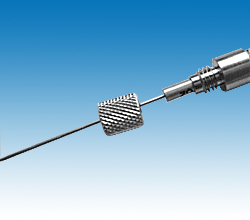
 ¿Qué
es MEPS?
¿Qué
es MEPS? ¿El efecto memoria es
significativo en MEPS?
¿El efecto memoria es
significativo en MEPS?